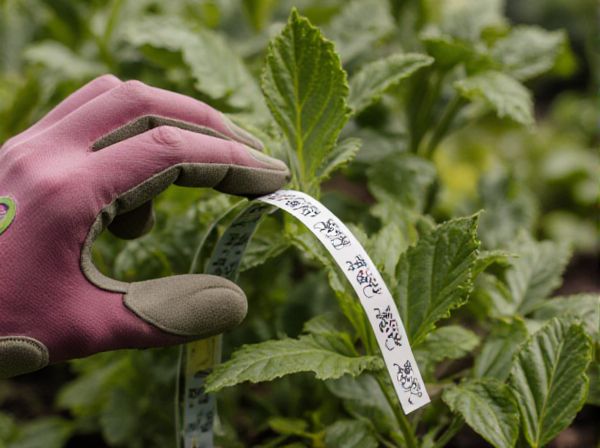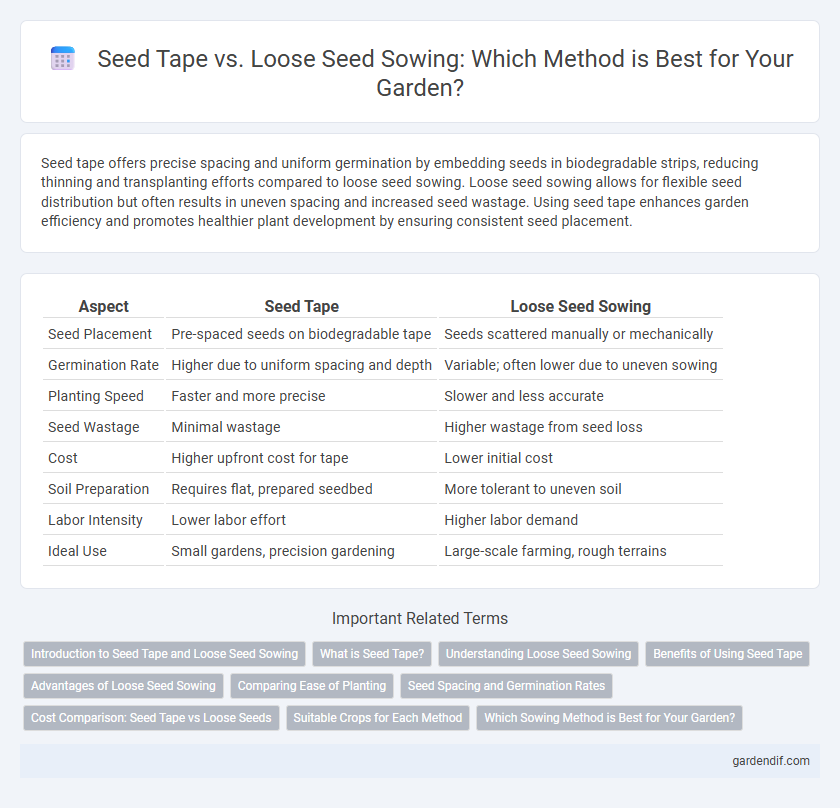
Seed tape vs Loose seed sowing Illustration
Seed tape offers precise spacing and uniform germination by embedding seeds in biodegradable strips, reducing thinning and transplanting efforts compared to loose seed sowing. Loose seed sowing allows for flexible seed distribution but often results in uneven spacing and increased seed wastage. Using seed tape enhances garden efficiency and promotes healthier plant development by ensuring consistent seed placement.
Table of Comparison
| Aspect | Seed Tape | Loose Seed Sowing |
|---|---|---|
| Seed Placement | Pre-spaced seeds on biodegradable tape | Seeds scattered manually or mechanically |
| Germination Rate | Higher due to uniform spacing and depth | Variable; often lower due to uneven sowing |
| Planting Speed | Faster and more precise | Slower and less accurate |
| Seed Wastage | Minimal wastage | Higher wastage from seed loss |
| Cost | Higher upfront cost for tape | Lower initial cost |
| Soil Preparation | Requires flat, prepared seedbed | More tolerant to uneven soil |
| Labor Intensity | Lower labor effort | Higher labor demand |
| Ideal Use | Small gardens, precision gardening | Large-scale farming, rough terrains |
Introduction to Seed Tape and Loose Seed Sowing
Seed tape offers a convenient, pre-spaced method for planting seeds, ensuring uniform germination and reducing thinning time compared to loose seed sowing. Loose seed sowing involves scattering seeds directly into the soil, which requires careful spacing and often results in uneven seed distribution and variable germination rates. Using seed tape enhances planting efficiency and maximizes crop yield by minimizing seed waste and optimizing growth conditions.
What is Seed Tape?
Seed tape is a pre-spaced, biodegradable strip embedded with seeds, designed to simplify planting and improve germination rates. Unlike loose seed sowing, seed tape ensures uniform seed placement, reduces seed wastage, and minimizes thinning labor. Ideal for small-scale gardeners and precision planting, seed tape enhances seedling success by providing optimal spacing and protection during germination.
Understanding Loose Seed Sowing
Loose seed sowing involves scattering seeds directly onto prepared soil, allowing for natural distribution and growth, which is often preferred for crops like carrots and lettuce due to ease and flexibility. This method requires careful watering and thinning to prevent overcrowding, ensuring optimal plant development and resource use. Understanding loose seed sowing aids gardeners and farmers in efficiently managing seed placement, reducing waste, and maximizing germination rates compared to more controlled methods like seed tape.
Benefits of Using Seed Tape
Seed tape improves planting accuracy by spacing seeds evenly, which reduces overcrowding and minimizes seed waste compared to loose seed sowing. It enhances germination rates through consistent seed depth and moisture retention, promoting uniform seedling growth. Using seed tape also saves time during planting and simplifies handling, making it ideal for small-scale and beginner gardeners.
Advantages of Loose Seed Sowing
Loose seed sowing offers greater flexibility in seed spacing, allowing for optimal plant growth and resource allocation. This method enhances seed-to-soil contact, improving germination rates and seedling vigor compared to seed tape. It also facilitates easier adjustment of sowing depth and density, adapting to various soil types and crop requirements efficiently.
Comparing Ease of Planting
Seed tape offers significantly greater ease of planting compared to loose seed sowing by providing pre-spaced seeds embedded in biodegradable tape, reducing the need for precise seed placement and thinning. Loose seed sowing requires more skill and effort to achieve uniform spacing and depth, often leading to uneven germination and wasted seeds. Using seed tape streamlines the planting process, especially for beginners, by minimizing labor and improving accuracy.
Seed Spacing and Germination Rates
Seed tape ensures precise seed spacing by embedding seeds at uniform intervals on a biodegradable strip, reducing overcrowding and promoting optimal root development. Loose seed sowing often results in uneven spacing, which can cause competition for nutrients and lower germination rates due to seed clustering or gaps. Studies show seed tape improves germination rates by providing consistent moisture contact and protecting seeds from displacement, leading to higher crop yields.
Cost Comparison: Seed Tape vs Loose Seeds
Seed tape offers cost savings by reducing seed wastage and ensuring precise spacing, which enhances germination rates and reduces the need for thinning. Loose seed sowing often results in uneven distribution, leading to higher seed consumption and increased labor costs for thinning and replanting. Overall, seed tape can lower expenses by improving seed efficiency and minimizing labor input compared to loose seed sowing.
Suitable Crops for Each Method
Seed tape is ideal for small-seeded crops such as lettuce, carrots, and radishes, as it ensures precise spacing and reduces thinning efforts. Loose seed sowing suits larger seeds like beans, corn, and peas, allowing for flexible planting depth and distribution. Choosing the method depends on crop size, planting accuracy, and desired spacing efficiency.
Which Sowing Method is Best for Your Garden?
Seed tape ensures evenly spaced seeds, reducing thinning time and improving germination rates, making it ideal for small garden beds and beginners. Loose seed sowing offers flexibility in planting density and is suited for large-scale gardens with experienced gardeners who can thin seedlings effectively. Choosing between seed tape and loose seed sowing depends on your garden size, skill level, and desired crop precision.
Seed tape vs Loose seed sowing Infographic

 gardendif.com
gardendif.com